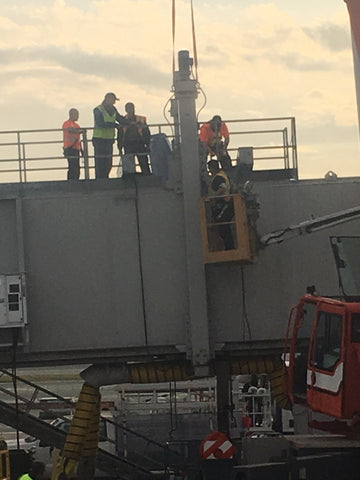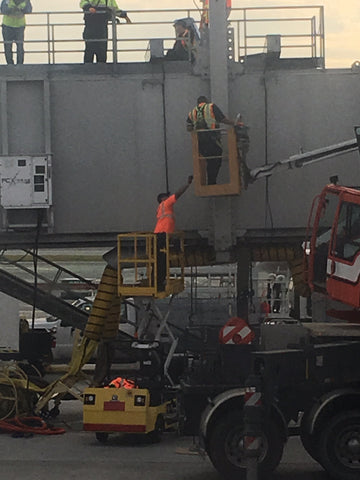Airport Construction Safety: An Observation of Why Tool Lanyards and Tool Tethering System Should be Necessary PPE
I fly a lot. Mostly I stick to 1 airline which means after hundreds of thousands of miles, I have status. I'm not bragging, my wife isn't impressed and she tends to be right about things. With status comes a lot of perks including free checked bags, the occasional upgrade and a not so secret phone number I can call when I need to talk to a real person. And of course, I also get priority boarding so I always have overhead bin space ready and waiting for my roll-aboard bag. Of course, once my bags are stored in the overhead bin and beneath the seat in front of me, I usually have a long time to sit before the plane departs.
Today, as usual I was seated, bags put away and still had 40 minutes before we pushed back. Unlike most days, out my window was a crew of 10 performing maintenance on a jet bridge at the gate next to mine. The crew had people on top of the jet bridge, below it and even operating 2 hoists. As an ISEA committee member responsible for developing standards for PPE, safety equipment, tool lanyards and tethers, I watched the team go to work with more interest than probably anyone else on the plane. For anyone working at height, it was quite the show indeed.
First, I must commend the team. They following conventional thinking and practice on working at height. The jet bridge had robust rails, the working in the lift had a proper looking safety harness connected to the lift, and the 6 or so on the ground were positioned away from the work being done. The worker, who was using a very large sledge hammer to break loose bolts, was also suited with a harness and tied off to the jet bridge.
I took these pictures originally with the intent to talk about how impressed I was at the team working at a modest height yet still using harnesses and proper safety equipment. Then something happened. I ask you, in the image below, what are they looking at?
There was an "oops". One of the workers was handing off 2 tools to one of his buddies. The larger of the 2, a very large wrench, seemed to take the focus so when they attempted an exchange of a smaller hand tool, it was fumbled and dropped over the side, bouncing off the tarmac below. THANKFULLY, nobody was hurt. The men on the ground in this image are on their way to retrieve the wayward tool and for the record, were not standing there when the tool dropped. However this highlighted to me yet again of the importance of tool lanyards and incorporating tool tethering solutions into PPE and other safety equipment. Had the hand tool been tethered using a tool lanyard or other safety device, it would have been handed off without incident and I would be commending the team on their fine work and their dedication to cutting edge safety scheme. That was not the case.
In the end, the tool was retrieved, and sent back up from ground level, handed via scissor lift, to the man in the hoist (image below), who then handed it off to the team on top of the jet bridge. It must have been an important hand tool as the recover effort and subsequent return too 5 minutes. I hope it wasn't damaged.
I will probably never know if this was recorded as a near miss. My guess is it won't be. Not because of the team working, I will always give the worker on the ground the benefit of the doubt. My guess is it won't be because so many still don't recognize the danger of falling objects. The paradigm of today it that drop was not avoidable, just an oops and since nobody was hurt, easily forgotten. Perhaps the believe tool lanyards to be a danger to the person wearing it, or that it will slow productivity. To the later of those "reasons" I highlight the many hand offs and delays caused by just 1 dropped tool. How can that slow work more than utilizing tool lanyards and tool tethers? To the former, the danger of using tool lanyards, I wish to highlight the need for retractable tethers. Retractable tool lanyards and tethering solutions, keep the tether short and tight, eliminating almost any change of catching on lifts, scaffolding, jet bridges (as in this post), ladders or almost anything else. If tool lanyards are the next generation of personal safety equipment, then tool tethering solutions are state of the art.
Next time you're on the tarmac, or just a floor below work being done, thing to yourself, is it safe to be standing here? If you're not sure, maybe the team above you should start including tool lanyards as part of their PPE.





